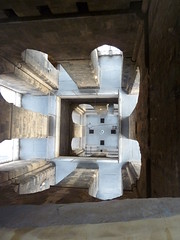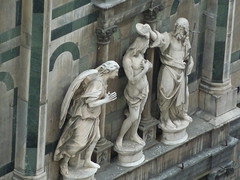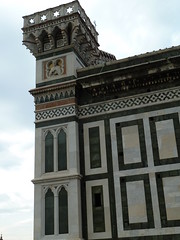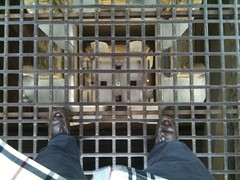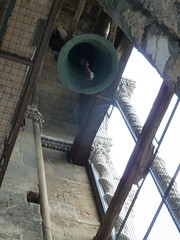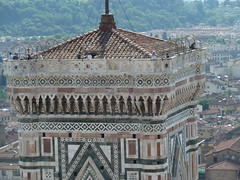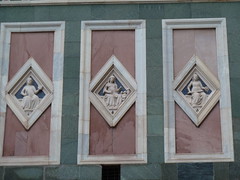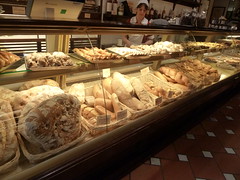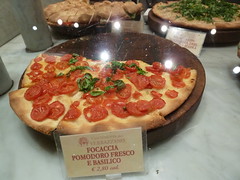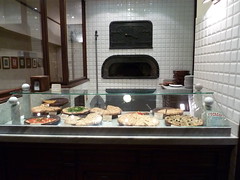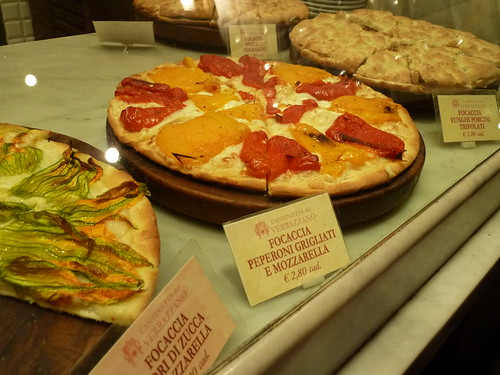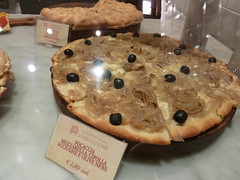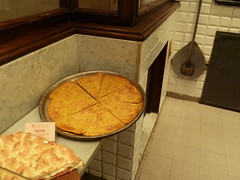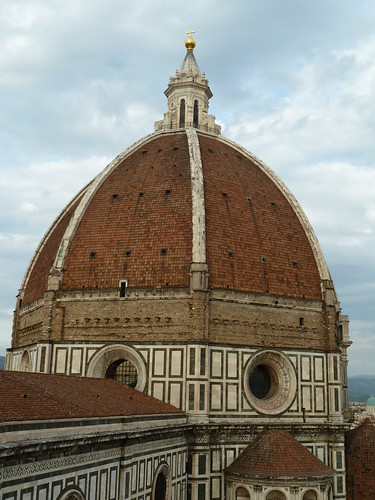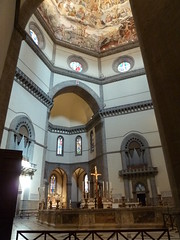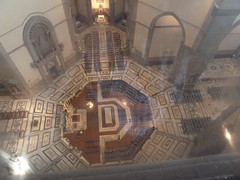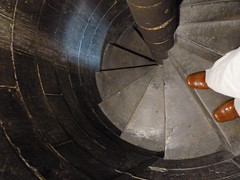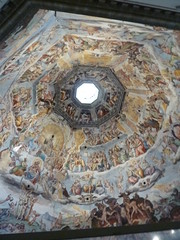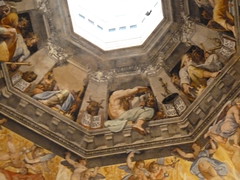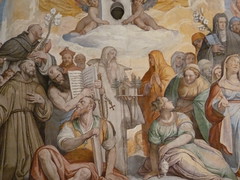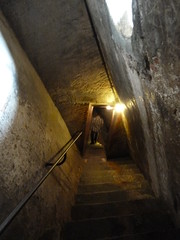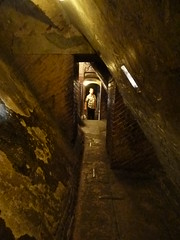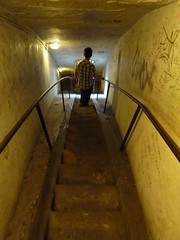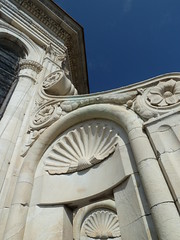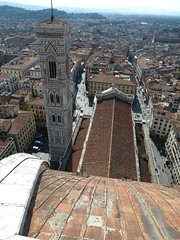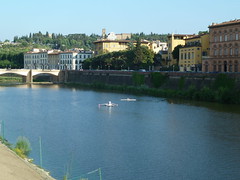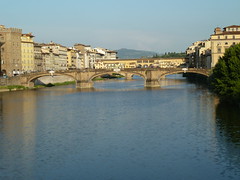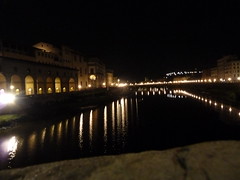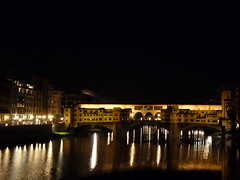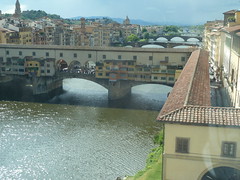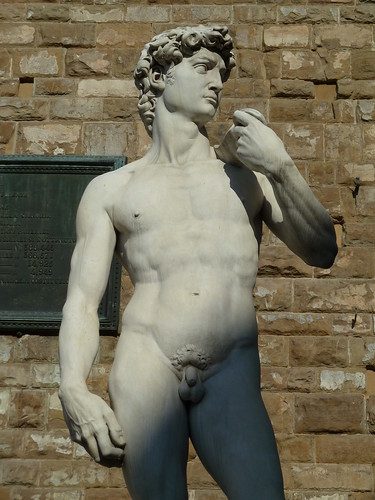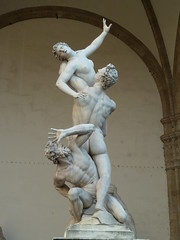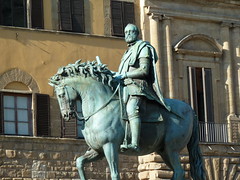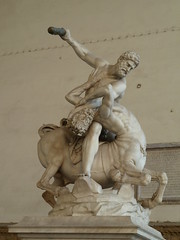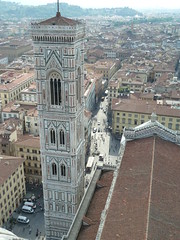 Having climbed the 463 steps to the top of Brunelleschi's dome, we had a breathtaking panoramic view of Florence, in which we could see nearly the entire city. Alas, the one thing we couldn't see from the dome was… the dome itself. Thus, there was nothing to be done for it, but to climb the 414 steps to the top of Giotto's campanile so that we could get a good look at where we had just been. So it was that after coming down from the dome, with a quick stop for resuscitation at Cantinetta di Verrazzano, we began the ascent of the campanile. Built in the mid-1300's, the campanile is nearly a century older than the dome, and of course there are stone spiral stairs to be climbed. But the ascent of the campanile is not as claustrophobic as the ascent of the dome, since the upper two thirds of the campanile are open in the interior. There are many more and larger windows, and the climb is broken by stops at the third, fourth, and fifth levels. Each upper level has a very open-feeling "room" with pairs of huge lancet arches open on all four sides, and a center which is open through the upper levels. The windows afford some great close views of the upper part of the cathedral and the dome, as well as views over the piazza and baptistry.
Having climbed the 463 steps to the top of Brunelleschi's dome, we had a breathtaking panoramic view of Florence, in which we could see nearly the entire city. Alas, the one thing we couldn't see from the dome was… the dome itself. Thus, there was nothing to be done for it, but to climb the 414 steps to the top of Giotto's campanile so that we could get a good look at where we had just been. So it was that after coming down from the dome, with a quick stop for resuscitation at Cantinetta di Verrazzano, we began the ascent of the campanile. Built in the mid-1300's, the campanile is nearly a century older than the dome, and of course there are stone spiral stairs to be climbed. But the ascent of the campanile is not as claustrophobic as the ascent of the dome, since the upper two thirds of the campanile are open in the interior. There are many more and larger windows, and the climb is broken by stops at the third, fourth, and fifth levels. Each upper level has a very open-feeling "room" with pairs of huge lancet arches open on all four sides, and a center which is open through the upper levels. The windows afford some great close views of the upper part of the cathedral and the dome, as well as views over the piazza and baptistry.On the fifth level, you can stand on a steel grate in the floor and look down an uncomfortably long way. You can see one or two of the bells above, and there is an older no-longer-used bell set out for close perusal, but they don't let you get too close to the seven active bells (five of which are 20th century, but the two largest are over three centuries old). As you climb the last part on steel staircases past where the bells are, they are closed off from view. We didn't get to discover what it's like to be in the bell tower when the bells ring. Probably an awesome experience, if a bit deafening.
 When you finally get to the roof of the tower, you can walk around all four sides, but you are completely fenced in including overhead. I guess they wanted to be certain nobody did anything stupid up there. It's pretty cool to look straight down to the piazza 280 feet below, and watch the people looking like ants. Even the top of the baptistry is far below.
When you finally get to the roof of the tower, you can walk around all four sides, but you are completely fenced in including overhead. I guess they wanted to be certain nobody did anything stupid up there. It's pretty cool to look straight down to the piazza 280 feet below, and watch the people looking like ants. Even the top of the baptistry is far below.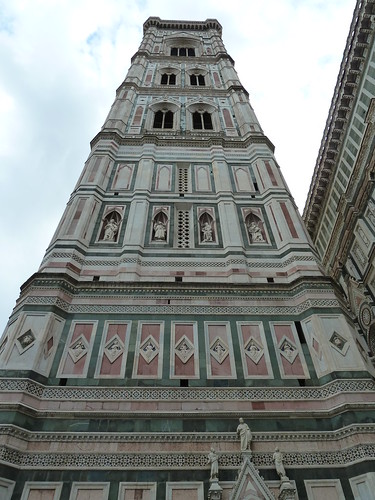 After we'd soaked up the views and finally descended, we paused to look back at the beautiful tower we'd just climbed. The facing uses the same tri-color marble (white, green, and red) that is used on the cathedral, and the same geometric designs. The tower is gracefully divided into five levels, each level being taller than the one below it. This trick of perspective makes the levels look evenly proportioned when regarded from below, while the tower still looks graceful from afar. The upper three levels feature pairs of double-lancet windows emphasizing verticality, while the lower two levels are subdivided into two bands each, making them look sturdier, yet all in harmonious proportion. The first band features a series of hexagonal panels with relief carvings showing stories from Genesis and allegories of the arts. The second band features lozenges on various themes: seven virtues on one side, seven sacraments on another, etc. The third band has statues of prophets, and the fourth band are simply white lancet slabs. All of these decorations are works of art in themselves. The ones in the tower now are all replicas. The originals have been moved inside where they can be preserved and you can get a better look at them.
After we'd soaked up the views and finally descended, we paused to look back at the beautiful tower we'd just climbed. The facing uses the same tri-color marble (white, green, and red) that is used on the cathedral, and the same geometric designs. The tower is gracefully divided into five levels, each level being taller than the one below it. This trick of perspective makes the levels look evenly proportioned when regarded from below, while the tower still looks graceful from afar. The upper three levels feature pairs of double-lancet windows emphasizing verticality, while the lower two levels are subdivided into two bands each, making them look sturdier, yet all in harmonious proportion. The first band features a series of hexagonal panels with relief carvings showing stories from Genesis and allegories of the arts. The second band features lozenges on various themes: seven virtues on one side, seven sacraments on another, etc. The third band has statues of prophets, and the fourth band are simply white lancet slabs. All of these decorations are works of art in themselves. The ones in the tower now are all replicas. The originals have been moved inside where they can be preserved and you can get a better look at them.
